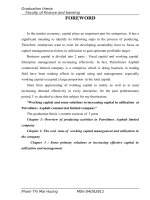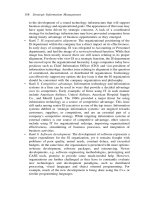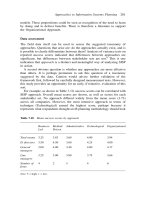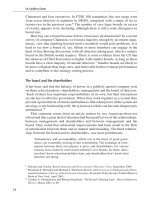working capital and strategic debtor management
Bạn đang xem bản rút gọn của tài liệu. Xem và tải ngay bản đầy đủ của tài liệu tại đây (3.26 MB, 102 trang )
Working Capital and Strategic Debtor
Management
Robert Alan Hill
Download free books at
Robert Alan Hill
Working Capital and Strategic Debtor
Management
Download free eBooks at bookboon.com
2
Working Capital and Strategic Debtor Management
1st edition
© 2013 Robert Alan Hill & bookboon.com
ISBN 978-87-403-0335-3
Download free eBooks at bookboon.com
3
Working Capital and Strategic
Debtor Management
Contents
Contents
Précis – Working Capital Management And Strategic Debtor Investment
8
Part One: An Introduction
9
1
An Overview
10
1.1
Introduction
10
1.2
Objectives of the Text
10
1.3
Outline of the Text
11
1.4
Summary and Conclusions
14
1.5
Selected References
14
Part Two: Working Capital Management
16
2
he Objectives and Structure of Working Capital Management
17
2.1
Introduction
17
2.2
he Objectives of Working Capital Management
19
2.3
he Structure of Working Capital
20
Potential
for exploration
ENGINEERS, UNIVERSITY
GRADUATES & SALES
PROFESSIONALS
Junior and experienced F/M
Total will hire 10,000 people in 2013.
Why not you?
Are you looking for work in
process, electrical or other types of
engineering, R&D, sales & marketing
or support professions such as
information technology?
We’re interested in your skills.
Join an international leader in the
oil, gas and chemical industry by
applying at
More than 600 job
openings are now online!
Potential
for development
Download free eBooks at bookboon.com
4
Click on the ad to read more
Copyright : Total/Corbis
www.careers.total.com
Working Capital and Strategic
Debtor Management
Contents
2.4
Summary and Conclusions
23
2.5
Selected References
24
3
he Accounting Concept of Working Capital: A Critique
25
3.1
Introduction
25
3.2
he Accounting Notion of Solvency
26
3.3
Liquidity and Accounting Proitability
28
3.4
Financial Interpretation: An Overview
29
3.5
Liquidity and Turnover
32
3.6
Summary and Conclusions
37
4
he Working Capital Cycle and Operating Eiciency
39
4.1
Introduction
39
4.2
he Working Capital Cycle
39
4.3
Operating Eiciency
41
4.4
Summary and Conclusions
46
5
Real World Considerations and the Credit Related Funds System
47
5.1
Introduction
47
5.2
Real World Considerations
48
www.sylvania.com
We do not reinvent
the wheel we reinvent
light.
Fascinating lighting offers an ininite spectrum of
possibilities: Innovative technologies and new
markets provide both opportunities and challenges.
An environment in which your expertise is in high
demand. Enjoy the supportive working atmosphere
within our global group and beneit from international
career paths. Implement sustainable ideas in close
cooperation with other specialists and contribute to
inluencing our future. Come and join us in reinventing
light every day.
Light is OSRAM
Download free eBooks at bookboon.com
5
Click on the ad to read more
Working Capital and Strategic
Debtor Management
Contents
5.3
he Credit Related Funds System
52
5.4
Summary and Conclusions
54
Part hree: Strategic Debtor Investment
55
6
he Efective Credit Price and Decision to Discount
56
6.1
Introduction
56
6.2
he Efective Credit Price
57
6.3
he Efective Discount Price
58
6.4
he Decision to Discount
60
6.5
Summary and Conclusions
66
7
he Opportunity Cost of Capital and Credit Related Funds System
67
7.1
Introduction
67
7.2
he Opportunity Cost of Capital Rate
67
7.3
he Credit Related Fund System
69
7.4
he Development of heory
71
7.5
Summary and Conclusions
74
7.6
Selected References
75
CHALLENGING PERSPECTIVES
Internship opportunities
EADS unites a leading aircraft manufacturer, the world’s largest
helicopter supplier, a global leader in space programmes and a
worldwide leader in global security solutions and systems to form
Europe’s largest defence and aerospace group. More than
140,000 people work at Airbus, Astrium, Cassidian and Eurocopter,
in 90 locations globally, to deliver some of the industry’s most
exciting projects.
An EADS internship offers the chance to use your theoretical
knowledge and apply it first-hand to real situations and assignments
during your studies. Given a high level of responsibility, plenty of
learning and development opportunities, and all the support you need,
you will tackle interesting challenges on state-of-the-art products.
We welcome more than 5,000 interns every year across
disciplines ranging from engineering, IT, procurement and
finance, to strategy, customer support, marketing and sales.
Positions are available in France, Germany, Spain and the UK.
To find out more and apply, visit www.jobs.eads.com. You can also
find out more on our EADS Careers Facebook page.
Download free eBooks at bookboon.com
6
Click on the ad to read more
Working Capital and Strategic
Debtor Management
8
Contents
he Strategic Impact of Alternative Credit Policies on Working Capital
and Company Proitability
76
8.1
Introduction
76
8.2
Efective Prices and the Creditor Firm
77
8.3
Alternative Credit Policies, Working Capital Investment
and Corporate Proitability
80
Summary and Conclusions
84
Part Four: Summary and Conclusions
85
9
Empirical Evidence and heoretical Review
86
9.1
Introduction
86
9.2
he heory
86
9.3
he Empirical Evidence
89
9.4
Late Payment and the Case for Legislation
95
9.5
Summary and Conclusions
99
9.6
Selected References
8.4
101
360°
thinking
.
Discover the truth at www.deloitte.ca/careers
© Deloitte & Touche LLP and affiliated entities.
Download free eBooks at bookboon.com
7
Click on the ad to read more
Working Capital and Strategic
Debtor Management
Précis
Précis – Working Capital
Management And Strategic Debtor
Investment
his free book critically evaluates working capital management and the strategic marketing function of
credit terms within a theoretical context of wealth maximisation and empirical research. he accounting
convention that management must present an image of solvency and liquidity to the outside world by
maintaining an excess of current assets over current liabilities is seriously questioned. A irm’s objectives
should be to minimise current assets and maximise current liabilities compatible with its debt paying
ability, based upon future cash proitability dictated by optimum terms of sale, which may be unique.
Download free eBooks at bookboon.com
8
Part One:
An Introduction
Download free eBooks at bookboon.com
Working Capital and Strategic
Debtor Management
An Overview
1 An Overview
1.1
Introduction
hroughout all the previous texts in my bookboon series (referenced at the end of this Chapter) we
deined Strategic Financial Management in terms of two inter-related policies:
The determination of a maximum net cash inlow from investment opportunities at an acceptable level of risk,
underpinned by the acquisition of funds required to support this activity at minimum cost.
You will also recall that if management employ capital budgeting techniques, which maximise the expected
net present value (NPV) of all a company’s investment projects, these inter-related policies should
conform to the normative objective of business inance, namely, the maximisation of shareholders wealth.
Having dealt comprehensively with the pivotal role of capital budgeting and ixed asset formation
elsewhere in the “Strategic Financial Management” texts of the bookboon series, the initial purpose of this
study is to focus on current asset investment and the strategic importance of working capital management.
Not only do current assets comprise more than 50 per cent of many irms’ total asset structure, but their
inancing is also an integral part of project appraisal that is frequently overlooked.
We shall then explain why the “terms of sale” (credit terms) ofered to customers determine a company’s
sales turnover and hence the debtor, inventory and cash balances, which deine its working capital
requirements. Properly conceived, debtor (accounts receivable) policies should underpin the proitability
of ixed asset formation, without straining liquidity or compromising a irm’s future plans.
Comprehensive, yet concise, all the material is presented logically as a guide to further study, using the
time- honoured approach adopted throughout all my bookboon series. Each Chapter begins with theory,
followed by its application and an aprropriate critique. From Chapter to Chapter, summaries of the text
so far are presented to reinforce the major points. Each Chapter also contains Activities (with indicative
solutions) to test understanding at your own pace.
1.2
Objectives of the Text
he text assumes that you have prior knowledge of Financial Accounting and an ability to interpret
corporate inancial statements using ratio analysis. So, at the outset, you should be familiar with the
following glossary of terms:
Working capital: a company’s surplus of current assets over current liabilities, which measures the extent
to which it can inance any increase in turnover from other fund sources.
Download free eBooks at bookboon.com
10
Working Capital and Strategic
Debtor Management
An Overview
Current assets: items held by a company with the objective of converting them into cash within the
near future. he most important items are debtors or account receivable balances (money due from
customers), inventory (stocks of raw materials, work in progress and inished goods) and cash or near
cash (such as short term loans and tax reserve certiicates).
Current liabilities: short term sources of inance, which are liable to luctuation, such as trade creditors
(accounts payable) from suppliers, bank overdrats and tax payable.
On completion of this text you should be able to:
- Distinguish between the internal working capital management function and an external
interpretation of a irm’s working capital position revealed by its published accounts,
- Calculate the working capital operating cycle and inancing cycle from published accounting
data and analyse the inter-relationships between the two,
- Deine the dynamics of a company’s credit-related funds system,
- Explain how the terms of sale, which comprise the credit period, cash discount and discount
period, afect the demand for a irm’s goods and services,
- Understand the impact of alternative credit policies on the revenues and costs which are
associated with a capital budgeting decision,
- Appreciate the disparities between the theory and practice of working capital management,
given our normative wealth maximisation assumption.
1.3
Outline of the Text
he remainder of our study is divided into three sections.
Part Two begins by explaining the relationship between working capital management and inancial
strategy. You are reminded that the normative objective of inancial management is the maximisation
of the expected net present value (NPV) of all a company’s investment projects. Because working capital
is an integral part of project appraisal, we shall deine it within this context.
We then reveal why the traditional accounting concept of working capital is of limited use to the inancial
manager. he long-standing rule that a irm should strive to maintain a 2:1 ratio of current assets to
current liabilities is questioned. Using illustrative examples and Activities you will be able to conirm that:
- Eicient working capital management should be guided by cash proitability, which may
conlict with accounting deinitions of solvency and liquidity developed by external users of
published inancial statements,
- An optimal working capital structure may depart from accounting conventions by relecting
a balance of credit-related cash lows, which are unique to a particular company.
Download free eBooks at bookboon.com
11
Working Capital and Strategic
Debtor Management
An Overview
Part hree initially considers how the terms of sale ofered by a company to its customers is a form of
price competition, which can inluence the demand for its goods and services. We shall begin by using
the time value of money concept within a framework of “efective prices” to explain how the availability
of credit periods and cash discounts for prompt payment provide customers with reductions in their
cash price.
Items bought on credit will be shown to create a utility in excess of their eventual purchase price
measured by the debtors’ opportunity to utilise this amount during the credit period, or discount period.
By conferring enhanced purchasing power upon its customers, a company’s terms of sale will be seen to
have true “marketing” signiicance. hey represent an aspect of inancial strategy, whereby the creditor
irm can translate potential demand into actual demand and increase future proitability. Your Activities
will conirm this.
For the provider of goods and services (the creditor irm) we then explain why the availability of trade
credit is not without cost:
- Invoiced payments for accounts receivable, which are deferred or discounted, represent a
claim to cash that has a value inversely related to the time period in which it is received,
- Credit policies are a key determinant of the structure, amount and duration of a irm’s total
working capital commitment tied to its price-demand function,
- Alternative credit policies, therefore, produce diferent levels of proit.
So, when a irm decides to sell on credit, or revise credit policy variables, it should ensure that the
incremental beneits from any additional investment exceed the marginal costs.
Part Four challenges the extent to which companies adhere to standard industry terms based on empirical
evidence. Given our critique of conventional working capital analysis compared to a time-honoured
theoretical framework for analysing efective prices associated with diferent credit terms.
- Typical cash discounts confer unnecessary beneits on cash customers,
- Non-discounting customers oten remit payment beyond the permitted credit period,
- Standard industry terms produce a sub-optimal investment in working capital, which do not
make an eicient contribution to proit.
Having applied diferent credit policy variables to practical illustrations throughout the text to evaluate
why adhering to existing terms or setting terms equal to those of competitors can fail to maximise the
combined proit on output sold and the terms of sale extended to diferent classes of customer, we shall
draw the following conclusion:
Download free eBooks at bookboon.com
12









